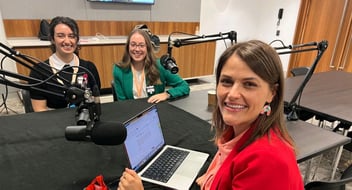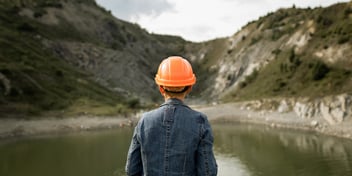Immersive program for highschool girls tackles gender diversity issues

In a bid to bolster the number of women within the water sector, a leading Australian consultancy has developed and implemented an immersive, week-long program to give female highschool students a taste of what it’s like to work in STEM.
GHD’s STEM Pathways Program has been designed to provide Year 10 female students with real exposure to the depth of roles and experiences available for them to pursue, while eliminating misconceptions about what it means to work in engineering.
GHD’s Process Engineer Rebecca Argento and Water Team Leader Maritsa Kacopieros are set to present at Ozwater’23 on the aims, successes and evolution of the successful program, which has now been running for six consecutive years.
Argento said the program was launched in 2017 to help address the lack of gender diversity in the sector by focusing closely on overcoming the barriers hindering early attraction of young students into STEM-related fields.
“Engineers Australia released a report in 2022 that identified encouraging high-school level students to study STEM subjects at school is an important element of getting more women into STEM fields,” she said.
“Looking at engineering in particular, the report found that over 51% of the female students surveyed didn’t go into engineering because they didn’t know anything about it. Half of the potential cohort are not aware of what engineering involves or what the day-to-day work looks like.
“A key area of focus for getting more women into STEM is combating this familiarity issue, and making more young people aware of what kind of work they can do within STEM fields, including how much of an impact the work can have on the community.”
Another key issue is that female students aren’t always encouraged into STEM-related studies in preparation for university, Argento said: “And, if they think they’re not good at math and science, they will move away from further study in those areas, too.
“Further, female students that excel in school tend to ‘tilt’ towards humanities subjects and careers in their later schooling and university choices, compared to males who will tilt towards STEM.”
GHD Water Team Leader Maritsa Kacopieros said addressing the pipeline must involve more of a focus on getting young women interested at the highschool level, as it has a big impact on decision-making around what to study at university.
“We need to increase familiarity, but also shift perceptions around what it actually means to work as an engineer. People who work in engineering say their work is impactful and fulfilling, but those perceptions don’t develop until engineers have been working in the field,” she said.
“A lot of our female colleagues have stories about that one teacher in highschool that encouraged them into engineering. We know first-hand that having support at the highschool level is really important in terms of guiding young women into STEM.”
Deeper exposure
Developed by GHD’s Monica George, the STEM Pathways Program was created to fill a gap in STEM engagement initiatives for highschool-aged students, Kacopieros said.
“Back before the program launched, there was already a lot happening in the tertiary space. But informing younger students about what engineering has to offer them starts before university. The impact needs to occur before students make choices about where they want to go with further study,” she said.
“And while there are other programs that exist, in the form of one-off workshops or excursions to universities, there wasn’t something that was hands-on and that actually gave highschool students an experience of what it is like to work as an engineer or scientist.”
The week-long, immersive work experience program is delivered through a timetable filled with an array of different activities associated with each student’s designated ‘mock role’ within the workplace, Kacopieros said.
“At the start of the week, the girls give us a preference on what type of discipline they might be interested in, which can be anything from structural engineering to geotech, electrical, science, architectural or project management,” she said.
“We then assign them a role and a team within that discipline, and a mock project for them to work on, which include all the different disciplines.”
The students are assigned set tasks to complete relating to their assigned roles on the project, and participate in presentations and facilitated sessions with clients and other organisations, exposing them to the importance of collaboration, communication, digital and stakeholder management.
“The students have to work together on problem solving and communicate with clients. We have collaboration sessions throughout the week to help guide the students and show them how the different disciplines interact on a project. This is a great way of showcasing how different fields of engineering are linked,” Kacopieros said.
The program has now been running for six consecutive years – including virtually, during COVID-19 lockdowns – and the results have been hugely successful, Kacopieros said.
“We do a survey with the students at the start of the week about what they think engineers do, and follow it up with another survey at the end of the week, too. We can really see what the students have learned, and can see the shift in their perception around what they know about engineering,” she said.
“We had six students in the first year. The biggest cohort we have had is 29 students. Last year we had 16. Five of the six girls that participated in 2017 are now studying STEM related fields at university, and they have all said that participating in this program encouraged them to do that.
“The program has evolved since that first year, but the premise has always stayed the same. And we can see the benefits for the students, but also the benefit for the staff, too.”
Showcasing opportunities
While aimed at giving students a first-hand look into a week in the life of an engineer, Kacopieros said the program also works to break down misconceptions and showcase how rewarding a career in STEM-fields can be.
“Part of the program is also making the students aware of how embedded engineering is in our day to day life, and how much engineering and science impacts everything that we do. Many STEM-related fields are about making life better for people, including the water sector,” she said.
“There is also a lot of really exciting work on offer within our industry that makes a huge impact on people’s lives globally. We do work with developing communities, work in disaster relief situations, and work in refugee camps on water supply and sanitation.
“It’s really rewarding to see the students' faces light up when they learn about all the potential pathways they can take with STEM.”
And with more and more young people wanting to work within roles that make a real difference, Argento said there is an opportunity for the sector to showcase just how rewarding working in water can be.
“The altruism behind engineering solutions should really be our selling point as an industry. But no-one at high-school level associated engineering with helping people,” she said.
“The link is not there, but this program is all about helping students make that connection.”
With the established STEM Pathways Program set to run again this year, Argento said GHD’s focus is now turning to expanding the positive impacts it brings by looking for opportunities to scale-up delivery.
“We have been chatting to a couple of water utilities about getting the program up and running in their offices, so that it’s not just a GHD program. We are really looking to expand the impact of the program by partnering with other water businesses,” she said.
“We currently run the program in Melbourne and Geelong with plans underway for programs in Wodonga and Sydney this year, but we want to reach more locations, including regional areas. GHD doesn’t have offices everywhere, so we want to work with other organisations to reach as many places and students as possible.”
Interested in hearing more from GHD’s Rebecca Argento and Maritsa Kacopieros about the STEM Pathways Program? Register for Ozwater’23 here.



